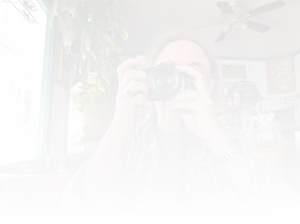Crop Factor (or Format Factor or Focal Length Multiplier)
(or go back to Photography page)
Confusion Runs Rampant!
There's a lot of confusion about what is variously called crop factor, cropping factor, focal length factor, format factor, crop multiplier, cropping multiplier, focal length multiplier, or format multiplier. My plan is to banish that confusion from your mind, because as it turns out, the idea is really pretty simple.
The first thing you need to know is that there's no focal length multiplication going on. That term is misleading and confusing, but is sometimes awfully useful if you're used to using lenses on a 35mm camera, or if you're reading an article in a magazine that's comparing lenses.
We're going to learn that the difference in sensor sizes make the same lens seem to work differently on different cameras. We'll also learn that the lens really always works the same, and we'll figure out what's really going on. When we're done, the concept will seem simple and obvious and you'll never forget it.
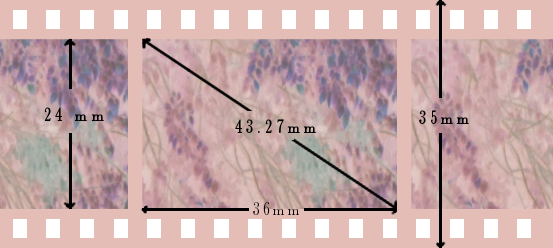
How big is a 35mm sensor?
The first thing we need to know is the size of a 35mm sensor. Then we'll look to see what happens with different focal length lenses with a 35mm camera. A 35mm camera focuses an image onto an area, the frame, of 35mm film of a size of 36mm X 24mm. It's only called 35mm, because that's the height of the strip of film, top to bottom.
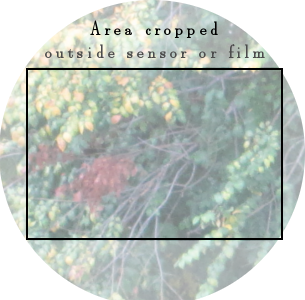
There's always cropping going on
The image projected by the lens is a larger circular image and is cropped by the edges of the film or sensor. This is a very important concept. This is the first time we've mentioned cropping, but it won't be the last. Cropping is when parts of the image on the outside get cut away. In this case, it's because some part of the image doesn't hit the sensor or film. If it doesn't hit the sensor or film, it won't get recorded.
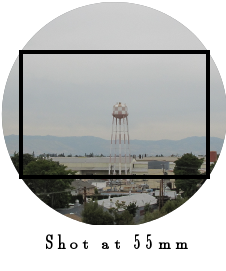
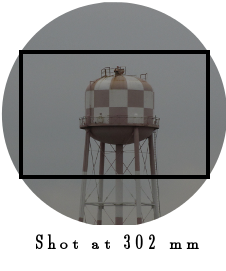
Focal length acts like a magnifier
Look at these pictures shot with a zoom lens. They show an image as projected on to the 35mm sized sensor. The first one is shot at a focal length of about 55mm, and the second one is zoomed in to a focal length of just over 300mm. You can see that the second image is zoomed in about 5 times. 302/55 is 5.49 times. It's what we would call a zoom of 5.5X.

Now, what's the difference with a smaller sensor?
The same lens, with a smaller sensor is still going to work just the same. A given focal length will project the same image, but now the target is going to be smaller. Sometimes much smaller. One example, called 1/2.3" size, runs 6.35mm X 4.75mm.
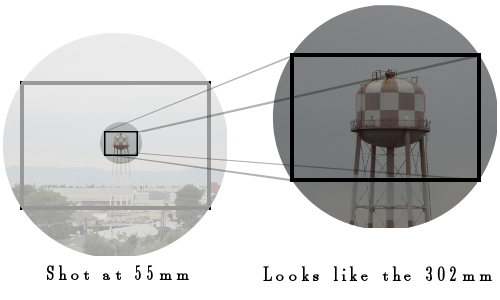
Look at the first image, the watertower shot at 55mm. Imagine a tiny little sensor in the middle of the image. No need to imagine it, look down at the picture below.
Look at that tiny rectangle in the middle of the picture. That's how small a 1/2.3" sensor, used on many digital cameras is when compared to the larger rectangle which represents a 35mm sized sensor.
If you blow that up, you'll see that the image that hits the sensor is just the same part of the water tower as showed up on the image that was shot at a focal length of 302mm. That's what they mean when they say that a crop factor of 5.5 is like a focal multiplier of 5.5. It doesn't make a 55mm lens act like a 302mm lens. The 55mm lens will still act exactly as it always does. It just means that most of the image projected by the 55mm lens is cropped off because the sensor is so small. The part left is just the same part of the image that a 35mm sensor would show if you zoomed in 5.5 times to a 302mm focal length.
Now you know that a 55mm lens is going to project the same image no matter what sensor you have, but a smaller sensor is going to show a lot less of it. If you were used to a 35mm camera before, you know that with a crop factor of 5.5, if you needed a 300mm lens for a shot, you'll get the same shot with a 55mm lens on your new camera. It's not because anything got multiplied though, it's just because your tiny sensor can only see a tiny part of the center of the image.
So how do they calculate crop factor?
CROPPING_FACTOR = 43.27 / DIAGONAL_OF_SENSOR
That's simple. Just divide the measurement of the diagonal of the 35mm sensor by the measurement of your sensor. In the example given, the diagonal of the 1/2.3" sensor is 7.93mm, so we divide that into the measurement of the 35mm sensor. 43.27 / 7.93 = 5.33, so the crop factor is really 5.33.
Here is information on a few sensor sizes
| Width (mm) | Height (mm) | Diagonal (mm) | Crop Factor | |
|---|---|---|---|---|
| Dalsa | 53.9 | 40.4 | 67.36 | 0.64 |
| Pentax | 44 | 33 | 55 | 0.79 |
| Leica | 45 | 30 | 54.08 | 0.80 |
| 35 mm Full Frame | 36 | 24 | 43.27 | 1.00 |
| Canon APS-H | 28.7 | 19 | 34.42 | 1.26 |
| APS-C non-Canon | 23.6 | 15.7 | 28.35 | 1.53 |
| APS-C Canon | 22.2 | 14.8 | 26.68 | 1.62 |
| Four Thirds | 17.3 | 13 | 21.64 | 2.00 |
| 1" | 13.2 | 8.8 | 15.86 | 2.73 |
| 2/3" | 8.6 | 6.6 | 10.84 | 3.99 |
| 1/1.7" | 7.6 | 5.7 | 9.5 | 4.55 |
| 1/2.3" | 5.76 | 4.29 | 7.18 | 6.03 |

